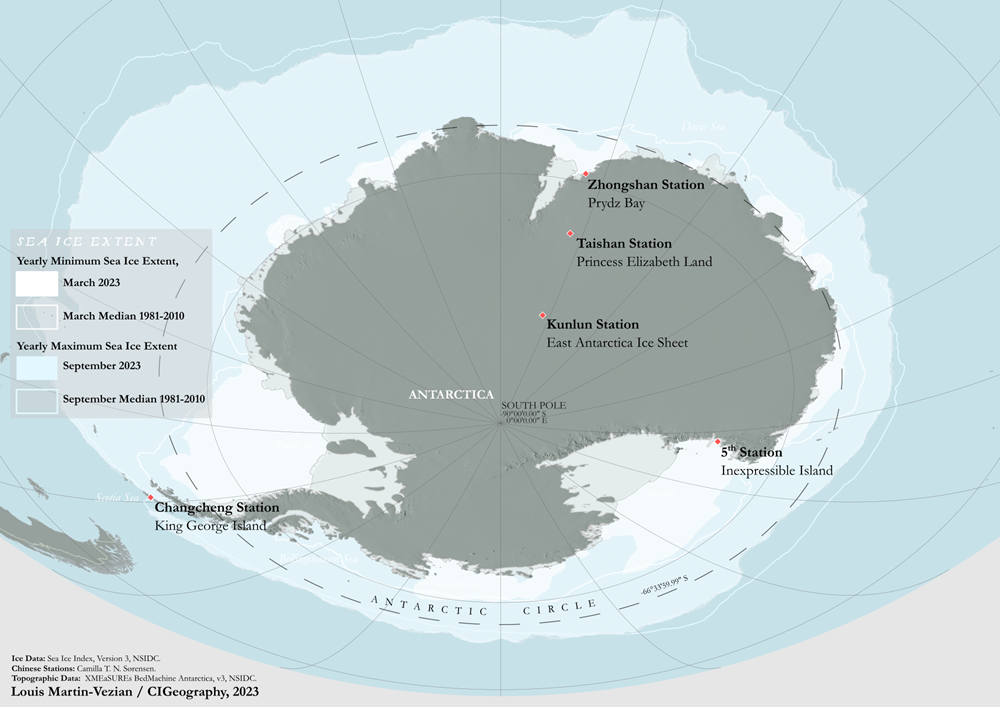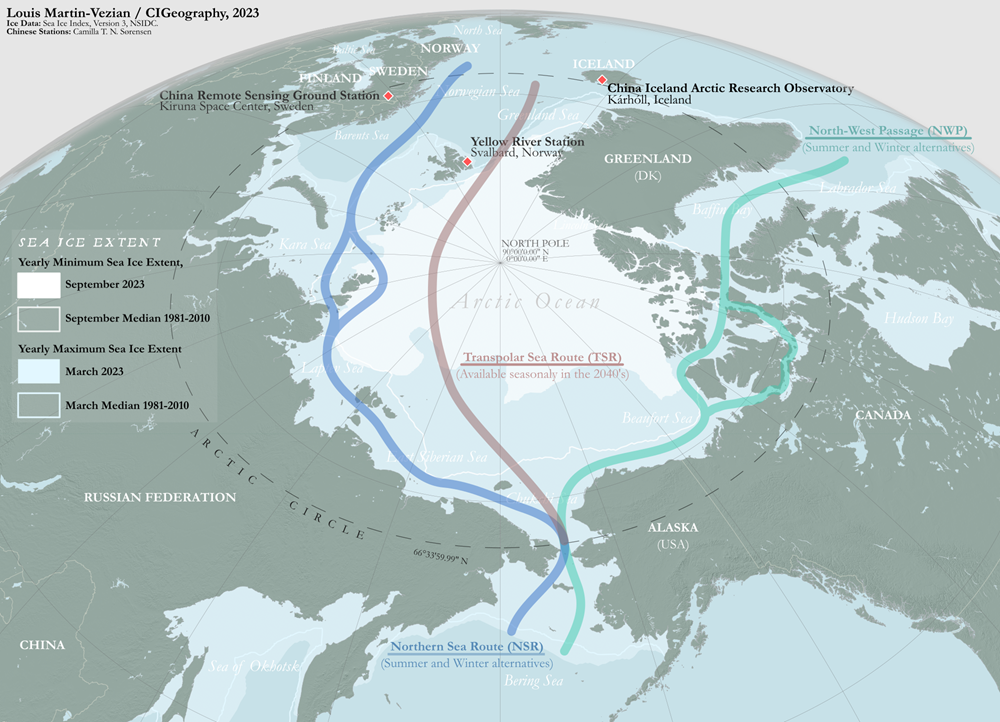Over the last two decades, China has significantly expanded its polar agenda and activities. It is a long-term strategic priority for China to establish itself as a legitimate and influential polar stakeholder with a permanent presence and access to conduct various activities in the Arctic and Antarctic. In Chinese strategic considerations and plans, the polar regions, together with the deep seabed and outer space, are categorized as “strategic spaces” [zhanlüe kongjian] or “new strategic frontiers” [zhanlüe xinjiang yu].1
China’s growing emphasis on ensuring itself an advantageous position in regulating and controlling access to these new strategic frontiers is often viewed as stemming from an expectation that these domains will be important for great-power struggles over critical resources and geopolitical influence.2 This is undoubtedly a key part of China’s motivation. However, there is also a strong link between China’s efforts to ensure its “polar stakeholder” position and achieve its “global scientific power” ambition. Beijing sees these new strategic frontiers as challenging areas in which to operate, resulting in constant pressure on Chinese researchers, engineers, and other experts to advance their knowledge and improve their technological capabilities.
The ability to conduct Chinese research expeditions and other activities in the polar regions is therefore also valued as a way to promote and raise the overall level of innovation and technology in China, which constitutes a key priority in the national development strategy for restructuring and upgrading its economic model.3 The knowledge and technology developed have parallel civilian and military uses—dual-use application—and therefore also play into Beijing’s “military-civilian fusion” strategy and the strategic priority of developing a world-class military.4 Such links between the domestic economic agenda and the polar regions have contributed to the continued emphasis on expanding China’s polar capacity and activities in key policy documents, despite the significant setbacks that Beijing has experienced, especially in the Arctic, in recent years.5
The Evolution of Chinese Polar Engagement
China’s polar engagement has come a long way since it took off in the mid-1980s in the Antarctic and the mid-1990s in the Arctic, driven primarily by an ambition to build Chinese polar research capacity.6 Initially, it was led by individual researchers and research institutions under the guidance of the State Oceanic Administration, which was established in 1964 under the Ministry of Natural Resources with the overall aim to “engage China in polar expeditions in the future.”7 This indicates that already at an early stage there was an expectation in China that ensuring access to the polar regions was important.
During the 1980s and 1990s, Chinese polar activities gradually became more centrally administrated and controlled. In 1989 the Polar Research Institute of China (PRIC) was founded to support scientific polar research, administer the polar research facilities, and provide logistic support for polar expeditions, with the first Chinese icebreaker Snow Dragon 1 arriving from Ukraine in the mid-1990s. China has been most active in the Antarctic. It established its first research station there in 1984 and conducted regular research expeditions throughout the 1990s. Today, China has four research stations in the Antarctic, and in April 2023 it restarted construction on a fifth during its 39th Antarctic expedition.8 It was only in 1999 that China conducted its first research expedition in the Arctic. By June 2023, however, it had conducted twelve Arctic expeditions. Regarding Arctic research facilities, China has had the Yellow River Station on Svalbard since 2004 and a smaller research facility in Iceland since 2018. In addition, it has several satellite receiver stations in the Antarctic and one in the Arctic in Kiruna, Sweden. These stations play a critical role in the Chinese BeiDou navigation satellite system.9

The research expeditions and facilities that China has set up point to a gradually expanding and increasingly ambitious polar research agenda, especially in the Antarctic but also in the Arctic. By all estimates, China today has significant polar research capabilities and competencies. In 2019, it added Snow Dragon 2, which is China’s first domestically built icebreaker. The vessel is a result of cooperation with a world-leading Finnish company and is equipped with cutting-edge oceanographic surveying and monitoring apparatus, allowing for advanced research in polar oceanography, biodiversity, and atmospheric and environmental conditions.10 A third Chinese nuclear-powered icebreaker is under construction.11
Through an examination of the post-expedition reports from Chinese researchers, it becomes clear that China today conducts cutting-edge experiments and probes on its polar expeditions. For instance, during its ninth Arctic expedition in 2018, Chinese researchers deployed unmanned observational equipment such as an indigenously produced autonomous underwater glider for deep-sea observation. Activities such as these have greatly enhanced China’s ability to observe and monitor the Arctic environment.12 Chinese polar research still centers on gaining a better understanding of the changing polar climate and ice conditions in order to better predict and prepare for the implications of climate change as well as to establish China as a valuable polar partner. This is what is often termed “science diplomacy,” where non-polar states seek to use research activities to legitimize and strengthen their polar presence and establish networks.13 Nevertheless, the content and focus of China’s polar research agenda have been gradually changing and broadening in the last decade. This is especially the case in recent years. The domestic focus on establishing China as a leading power in innovative new technologies has been further emphasized as the great-power competition with the United States has intensified. Similar to the United States, China has prioritized reducing its dependencies and thus increasing its self-reliance, especially in critical resources and key technologies.14
Chinese Polar Interests
As highlighted above, China sees its presence and influence in the polar regions as essential to provide access to critical resources, such as oil, gas, and rare earth minerals. These resources are abundant in the polar regions and are now becoming more accessible. Furthermore, China possesses one of the world’s largest distant-water fishing fleets and is increasingly interested in ensuring access to new fishing grounds. This relates to the more specific Chinese emphasis on securing favorable access to Arctic sea routes. Besides their importance for extracting Arctic resources, these routes are considered attractive alternatives to the longer and strategically vulnerable routes through the Strait of Malacca and the Suez Canal. A significant portion of China’s maritime trade passes through the Malacca Strait. Already back in 2003, then president Hu Jintao coined the term “Malacca dilemma” [Maliujia kunjing] to highlight how China’s dependence on this critical entry-exit point for upholding its economy, and hence security, creates vulnerabilities that need to be mitigated.15 Chinese concerns about this dependence and potential alternative routes have only increased since then, as China’s relations with the United States and several of its Southeast Asian neighbors have deteriorated.

The Transpolar Sea Route cutting straight across the North Pole seems to attract the most Chinese attention.16 It is the shortest of the three Arctic sea routes, but it is especially attractive from the Chinese perspective because unlike the Northern Sea Route and the Northwest Passage it runs mostly through international waters, where all states have freedom of navigation. Chinese ships would thus not have to follow the specific regulations of the relevant Arctic state, most significantly Russia in relation to the Northern Sea Route.
More generally, China has emphasized polar engagement as a means to advance its overall level of innovation and technology. The Made in China 2025 strategy identifies key sectors or industries such as robotics, space technology, artificial intelligence, the next generation of communication and information technology, and maritime technology and capabilities. Within these sectors or industries, China aims to take the lead by setting global standards through targeted investments, acquisitions, and research and development.17 This is also one of the main drivers behind the Belt and Road Initiative, which since June 2017 has included the Arctic sea routes under the heading “Polar Silk Road.”18 Consequently, the expanding polar engagement also reflects Beijing’s ambition to play a key role in negotiating and deciding on global standards, rules, and regulations. This is especially a Chinese priority in relation to these new strategic frontiers that are still rather unexplored and unregulated spaces. In other spaces, China sees itself as a latecomer and thus as disadvantaged. Through the leadership of the new strategic frontiers there is an opportunity for China to be involved from the beginning and even take a dominating role.19
In sum, it is evident that there is a significant polar dimension to the key Chinese strategies published in the recent decade, linking China’s polar engagement with its long-term ambitions and vision.
New Opportunities for a More Assertive Chinese Polar Strategy
In recent years, Beijing has experienced significant setbacks in its effort to establish itself as a legitimate and influential polar stakeholder. China’s strategy has been to knit itself into the polar regions on multiple levels, through bilateral and multilateral agreements and engagements within research, infrastructure, and resource extraction. This has especially been the case in the Arctic. However, the overall growing concerns in both the United States and Europe about the intentions of a stronger and more assertive China have made the Western Arctic states considerably reluctant to engage with China.20 Chinese activities have come under scrutiny in the Antarctic as well.21
Beijing’s unwillingness to distance itself from Russia following the country’s full-blown invasion of Ukraine in February 2022 further complicates China’s polar engagement by increasing the overall level of suspicion and wariness among Western states. On the other hand, it also opens new opportunities for China to challenge the weakened polar governance regimes as well as to take advantage of a weakened Russia that is more dependent on China.22 China potentially now has more room to promote its long-standing argument about the ineffectiveness and indeterminateness of the existing institutional and legal architecture in the polar regions.
From Beijing’s perspective, the polar regions belong to the common heritage of humankind, which means that all states should have the right to participate in and help shape their future governance.23 Beijing, therefore, prefers alternative governance regimes that allow non-polar states to have more influence. In the coming years, China likely will more openly start to question and challenge the existing polar governance regimes, highlighting its growing presence, activities, and technological capabilities in the polar regions as justification for its polar authority and legitimacy. The vital issue for Beijing is to ensure its participation in negotiating and deciding on the rules and regulations of these regions and, with time, to ensure that the way China prefers to conduct its activities informs how the polar governance regimes evolve. In the Antarctic, in particular, China is increasingly challenging the legal setup and presenting its interpretations of the Antarctic Treaty, calling for less regulation of Chinese activities, including military activities.24
In the coming years, China will likely intensify such efforts to gradually—though still cautiously—shape polar governance regimes to its advantage without provoking a significant reaction or countermove from polar states. This trend, therefore, should be followed closely.25
Camilla T. N. Sorensen is an Associate Professor in the Institute for Strategy and War Studies at the Royal Danish Defense College.
IMAGE CREDITS
Banner illustration by Nate Christenson ©The National Bureau of Asian Research.
Chinese research stations in Antarctica | Louis Martin-Vezian / CIGeography, 2023; Ice Data: Sea Ice Index, Version 3, NSIDC; Chinese Stations: Camilla T. N. Sorensen
Shipping routes and Chinese research stations in the Arctic region | Louis Martin-Vezian / CIGeography, 2023; Ice Data: Sea Ice Index, Version 3, NSIDC; Chinese Stations: Camilla T. N. Sorensen
ENDNOTES
- Zhanlüe xue [The Science of Military Strategy] (Beijing: Military Science Press, 2013), 74, nuke.fas.org/guide/china/sms-2013.pdf; “Guojia anquan fa cao’an ni zengjia taikong deng xinxing lingyu de anquan wei renwu” [The Draft National Security Law Will Increase Security in Space and Other New Areas], Xinhua, June 24, 2015, http://www.chinanews.com/gn/2015/06-24/7363693.shtml; and Ministry of National Defense of the People’s Republic of China (PRC), “Zhonghua renmin gongheguo guojia anquan fa” [National Security Law of the People’s Republic of China], art. 32, July 1, 2015, http://www.mod.gov.cn/regulatory/2016-02/19/content_4621258_3.htm.
- See Anne-Marie Brady, China as a Polar Great Power (Cambridge: Cambridge University Press, 2017), 255.
- Camilla T.N. Sorensen and Christopher W. Hsiung, “The Role of Technology in China’s Arctic Engagement: A Means as well as an End in Itself,” in Arctic Yearbook 2021, ed. Lassi Heininen, Heather Exner-Pirot, and Justin Barnes (Akureyri: Arctic Portal, 2021), https://arcticyearbook.com/images/yearbook/2021/Scholarly-Papers/11_AY2021_Sorensen_Hsiung.pdf.
- The focus of the “military-civilian fusion” strategy is to increase integration between China’s civil research and commercial sectors and its military, law-enforcement, and defense industrial sectors. See, for example, Elsa B. Kania, “In Military-Civil Fusion, China Is Learning Lessons from the United States and Starting to Innovate,” Strategy Bridge, August 27, 2019, https://thestrategybridge.org/the-bridge/2019/8/27/in-military-civil-fusion-china-is-learning-lessons-from-the-united-states-and-starting-to-innovate.
- See, for example, the 14th Five-Year-Plan from March 2021, available at https://www.gov.cn/xinwen/2021-12/28/5664873/files/1760823a103e4d75ac681564fe481af4.pdf.
- See Brady, China as a Polar Great Power, 43–59.
- Ties Dams, Louise van Schaik, and Adája Stoetman, “Presence before Power. China’s Arctic Strategy in Iceland and Greenland,” Clingendael, Report, June 2020, 6–7, https://www.clingendael.org/sites/default/files/2020-06/presence-before-power.pdf.
- “Surveillance Fears as China Resumes Construction on Fifth Antarctic Base,” Reuters, April 18, 2023, available at https://www.theguardian.com/world/2023/apr/18/china-antarctic-station-inexpressible-island.
- Brady, China as a Polar Great Power, 107–13.
- Zhao Lei, “Icebreaker, Satellite and Stations Bridge Polar Research Gap,” China Daily, September 30, 2019, https://www.chinadaily.com.cn/a/201909/30/WS5d9178efa310cf3e3556e5cf.html.
- Chinese researchers often highlight that their contribution to the development of polar-related science and technology is also a way to establish China as an important polar nation. Lulu Zhang et al., “Reforming China’s Polar Science and Technology System,” Interdisciplinary Science Reviews 44, no. 3–4 (2019): 392.
- Zexun Wei et al., “Overview of the 9th Chinese National Arctic Research Expedition,” Atmospheric and Oceanic Science Letters 13, no. 1 (2020): 1–7.
- Trym Eilerjord, “Checking Back in on China’s Icebreakers,” Diplomat, February 13, 2023, https://thediplomat.com/2023/02/checking-back-in-on-chinas-nuclear-icebreaker.
- Bates Gill, “China’s Quest for Greater Technological Self-Reliance,” Asia Society, March 21, 2021, https://asiasociety.org/australia/chinas-quest-greater-technological-self-reliance.
- For further context and analysis, see You Ji, “Dealing with the Malacca Dilemma: China’s Effort to Protect Its Energy Supply,” Strategic Analysis 31, no. 3 (2007): 467–89.
- Mia Benneth, “The Arctic Shipping Route, No One Is Talking Abort,” Maritime Executive, August 5, 2019, https://www.maritime-executive.com/editorials/the-arctic-shipping-route-no-one-s-talking-about?__ac_lkid=3e7-cc58-1ee8-9f6d17170d5ecfa.
- Elsa B. Kania, “Made in China 2025, Explained,” Diplomat, February 1, 2019, https://thediplomat.com/2019/02/made-in-china-2025-explained.
- “China Unveils Vision for ‘Polar Silk Road’ Across Arctic,” Reuters, January 26, 2018, https://www.reuters.com/article/us-china-arctic-idUSKBN1FF0J8.
- Zhanlüe xue, 249.
- Stephanie Pezard et al., China’s Strategy and Activities in the Arctic. Implications for North American and Transatlantic Security (Santa Monica: RAND Corporation, 2022), https://www.rand.org/pubs/research_reports/RRA1282-1-v2.html.
- Clair Young, “Eyes on the Prize. Australia, China and the Antarctic Treaty System,” Lowy Institute, Policy Brief, February 15, 2021, https://www.lowyinstitute.org/publications/eyes-prize-australia-china-antarctic-treaty-system.
- Camilla T. N. Sorensen and Jørgen Staun, “Incompatible Strategic Cultures Limit Russian-Chinese Strategic Cooperation in the Arctic,” Scandinavian Journal of Military Studies 6, no. 1 (2023): 24–39.
- See, for example, State Council Information Office (PRC), China’s Arctic Policy (Beijing, January 2018), https://www.chinadailyasia.com/articles/188/159/234/1516941033919.html; and Brady, China as a Polar Great Power, 16–32.
- Anthony Bergin and Tony Press describe China as “an active, vocal and at a times disruptive, unconstructive, presence in Antarctic Treaty System (ATS) meetings, underlining a growing diplomatic assertiveness in Antarctic affairs.” See Anthony Bergin and Tony Press, “Eyes Wide Open: Managing the Australia-China Antarctic Relationship,” Australian Strategic Policy Institute, April 2020, https://www.aspi.org.au/report/eyes-wide-open-managing-australia-china-antarctic-relationship.
- Camilla T. N. Sorensen, “The Evolving Chinese Strategy in the Arctic: Entering the Grey Zone?” in Hybrid Threats and Grey Zone Conflicts: A Challenge to Liberal Democracies, ed. Mitt Regan and Aurel Sari (Oxford: Oxford University Press, forthcoming in 2024).

